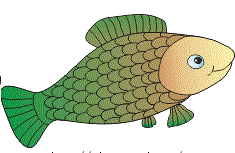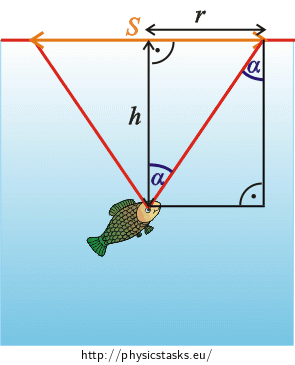What Is the Area of the Sky Seen by a Fish?
Classical Mechanics
Level
2
Fish is in the depth of 3 m looking towards the surface. What is the area of the placid water surface in which the fish sees the sky? ( in meters)

47.2
cannot be determined
368
0
397.67
5.987
36.8
3698.7
This section requires Javascript.
You are seeing this because something didn't load right. We suggest you, (a) try
refreshing the page, (b) enabling javascript if it is disabled on your browser and,
finally, (c)
loading the
non-javascript version of this page
. We're sorry about the hassle.
Trajectory of the light beams and the shape of the area in which the fish sees the sky
We assume the fish’s eye as the point in which the rays converge.
The area will be circular with the radius r
The beams which are incident on the surface at the angle of 90°
Now we focus only on the beams that are refracted at the angle α (see „Picture of the beams“).
We derive the relation for the angle of refraction α from Snell’s law:
sin α sin 9 0 ° = n 1 n 2
where n 1 is the refractive index of air and n 2 is the refractive index of water.
since sin 9 0 ° = 1 , we can write:
sin α 1 = n 1 n 2 Therefrom we express sin α :
sin α = n 2 n 1 , ( 2 )
Due to the similarity of triangles we can adjust the picture as follows:
We can see from the picture that sin α = r 2 + h 2 r , ( 3 ) where r 2 + h 2 is a hypotenuse of the triangle and we have determined its length from the Pythagorean theorem. Size of the desired area
If we multiply both sides of the equation (3) by r 2 + h 2 r = r 2 + h 2 ⋅ sin α
According to (2)) we substitute sinα: r = r 2 + h 2 ⋅ n 2 n 1
We raise both sides of the equation to the power of two and multiply the brackets: r 2 = ( r 2 + h 2 ) ⋅ ( n 2 n 1 ) 2 = r 2 ( n 2 n 1 ) 2 + h 2 ( n 2 n 1 ) 2
Then we subtract r 2 ( n 2 n 1 ) 2 from both sides of the equation and factor out r 2 r 2 [ 1 − ( n 2 n 1 ) 2 ] = h 2 ( n 2 n 1 ) 2 We divide both sides of the equation by [ 1 − ( n 2 n 1 ) 2 ] and extract the root:
r = 1 − ( n 2 n 1 ) 2 h ( n 2 n 1 ) = n 2 1 − ( n 2 n 1 ) 2 h ⋅ n 1
We convert the expression inside the square root to the common denominator and adjust the fraction:
r = n 2 n 2 2 n 2 2 − n 1 2 h ⋅ n 1 = n 2 2 − n 1 2 h ⋅ n 1
We substitute r in relation (1) and raise the whole equation to the power of two:
S = π r 2 = π ⋅ ( n 2 2 − n 1 2 h ⋅ n 1 ) 2 = π ⋅ n 2 2 − n 1 2 h 2 ⋅ n 1 2
Numerical solution: We know from the task assignment: h=3 m.
We look up the values of π , n2 and n1 in the Tables:
Ludolph’s number π = ˙ 3 . 1 4 Refractive index of air n 1 = ˙ 1 . 0 0 Refractive index of water n 2 = ˙ 1 . 3 3
We substitute for the values and obtain the size of the desired area:
S = ˙ 1 . 3 3 2 − 1 . 0 0 2 3 . 1 4 ⋅ 3 2 . 1 . 0 0 2 m 2 = 1 . 3 3 2 − 1 3 . 1 4 ⋅ 9 ⋅ 1 m 2 = 3 6 . 8 m 2